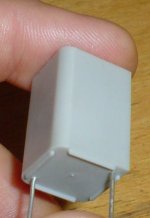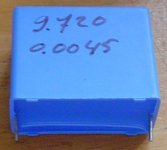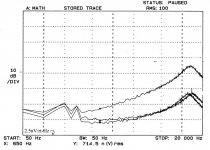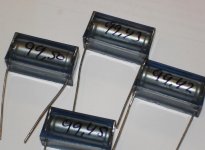Besides Koenigsegg, i can think of only 1 other reason for wishing to reside in Sweden. 
A shame they also stopped making the PFE216 series.(90n9 is the best i manage, but i do have a SL of them)
Still amusing though how much some folks are willing to pay for them: high, compared to how far a sporadic white trash diyA-member goes=> low
(personally, i fancy Grey more than Black RTE, at 1.25% it doesn't spring the bank for having to buy >4 times as many RelCap's to select a few good ones)
None will have a problem with the 5.2/2.6 to 6dB bit, just a shame of losing the other -10dB.

A shame they also stopped making the PFE216 series.(90n9 is the best i manage, but i do have a SL of them)
Still amusing though how much some folks are willing to pay for them: high, compared to how far a sporadic white trash diyA-member goes=> low
(personally, i fancy Grey more than Black RTE, at 1.25% it doesn't spring the bank for having to buy >4 times as many RelCap's to select a few good ones)
None will have a problem with the 5.2/2.6 to 6dB bit, just a shame of losing the other -10dB.
Attachments
jacco vermeulen said:
None will have a problem with the 5.2/2.6 to 6dB bit, just a shame of losing the other -10dB.
With regard to?
RIFA
Jacco -
you must be the Master of finding obsolete components! You never stop to surprise me.
I searched for PFE210 / PFE216 a year ago, and came up with nothing. My stock is very small.
Your 90n9 caps would make a very good RIAA amplifier!
The price you call "high" is actually a very good price. Even better these days when the USD is so low 😀
60 USD for 10 of these is a bargain!
RIFA still makes the great PEH169 and PEH200 electrolytic caps,
and the new PFR is a nice film and foil PP cap. I somtimes use their PHE450 and PHE426, and also their X2 cap PHE840.
Still going strong.....
I once worked for RIFA (Power Division).
Sigurd
Jacco -
you must be the Master of finding obsolete components! You never stop to surprise me.
I searched for PFE210 / PFE216 a year ago, and came up with nothing. My stock is very small.
Your 90n9 caps would make a very good RIAA amplifier!
The price you call "high" is actually a very good price. Even better these days when the USD is so low 😀
60 USD for 10 of these is a bargain!
RIFA still makes the great PEH169 and PEH200 electrolytic caps,
and the new PFR is a nice film and foil PP cap. I somtimes use their PHE450 and PHE426, and also their X2 cap PHE840.
Still going strong.....
I once worked for RIFA (Power Division).
Sigurd
jacco vermeulen said:Besides Koenigsegg, i can think of only 1 other reason for wishing to reside in Sweden.
A shame they also stopped making the PFE216 series.(90n9 is the best i manage, but i do have a SL of them)
Still amusing though how much some folks are willing to pay for them: high, compared to how far a sporadic white trash diyA-member goes=> low
(personally, i fancy Grey more than Black RTE, at 1.25% it doesn't spring the bank for having to buy >4 times as many RelCap's to select a few good ones)
None will have a problem with the 5.2/2.6 to 6dB bit, just a shame of losing the other -10dB.
Capacitor selection
Reading Jacco's post about buying many caps to select the ones that are within the tolerance one wants to have,
I would point out another way of doing things,
and that is to take a cap and measure it accurately,
and then change the resistor values accordingly by calculation/simulation/measurements.
This means that the resistor values will differ a bit between left and right channels, but as long as we are talking about a few percent hither or dither, it is not important.
Important it is, to have left and right channels closely matched. Probably more important than having < +-0.xx dB RIAA accuracy.
Sigurd
Reading Jacco's post about buying many caps to select the ones that are within the tolerance one wants to have,
I would point out another way of doing things,
and that is to take a cap and measure it accurately,
and then change the resistor values accordingly by calculation/simulation/measurements.
This means that the resistor values will differ a bit between left and right channels, but as long as we are talking about a few percent hither or dither, it is not important.
Important it is, to have left and right channels closely matched. Probably more important than having < +-0.xx dB RIAA accuracy.
Sigurd
PMA said:With regard to?
Paragraph 3.1 of Mr Vogel
(25-30 years of toying around with electronics and RIFA quality parts not only results in grey hair, Mr Ruschkow[ski]. Plus, once I used to reside in the same city as the Ebay seller + visit his shop)
Even with junk parts, but i favor <0.1dB both ways.
Attachments
It's nicer to hold between your fingers, think i'm too old for the E-book millenium. (but they charged me €110 for it a month ago)
phono noise
John Curl suggested I put a real cartridge body in as a source resistor in my Quantec. This is the result for a standard Shure body for a bipolar (top-AD797/LT1028 style) and FET (bottom 2 OPA627 style). This is MM of course but interesting result. The loading was the recommended 47K and 220pF?
John Curl suggested I put a real cartridge body in as a source resistor in my Quantec. This is the result for a standard Shure body for a bipolar (top-AD797/LT1028 style) and FET (bottom 2 OPA627 style). This is MM of course but interesting result. The loading was the recommended 47K and 220pF?
Attachments
Re: phono noise
Hi Scott,
that is a good illustration. It could be useful as well to check for the frequency response variations with a real cartridge source. MM usually have L near 0.5H and R about 500-700 Ohm - that is why FET input is quieter with MM, the current noise of BJT input really hurts here.
Cheers
Alex
scott wurcer said:John Curl suggested I put a real cartridge body in as a source resistor in my Quantec. This is the result for a standard Shure body for a bipolar (top-AD797/LT1028 style) and FET (bottom 2 OPA627 style). This is MM of course but interesting result. The loading was the recommended 47K and 220pF?
Hi Scott,
that is a good illustration. It could be useful as well to check for the frequency response variations with a real cartridge source. MM usually have L near 0.5H and R about 500-700 Ohm - that is why FET input is quieter with MM, the current noise of BJT input really hurts here.
Cheers
Alex
Re: phono noise
My is MC, loading is like 50 - 200 ohm // 2 - 10nF. My sample measured was for equivalent resistance of some 200ohm. Generator via voltage divider, in fact current source. So the load resistor + ev. series resistor with input estimate noise equivalent resistance.
For MM, we can see importance of low input current noise density. For MC, input voltage noise dominates, if R is small enough. But Kelvin noise and input noise current take part as well.
scott wurcer said:The loading was the recommended 47K and 220pF?
My is MC, loading is like 50 - 200 ohm // 2 - 10nF. My sample measured was for equivalent resistance of some 200ohm. Generator via voltage divider, in fact current source. So the load resistor + ev. series resistor with input estimate noise equivalent resistance.
For MM, we can see importance of low input current noise density. For MC, input voltage noise dominates, if R is small enough. But Kelvin noise and input noise current take part as well.
Re: Re: phono noise
... is this really relevant? If you add the RIAA curve to this what will the noise properties be then? ... and when you put the needle in the grooves, what about then? Interesting to compare real life specifications. What is the minimum really?PMA said:For MM, we can see importance of low input current noise density. For MC, input voltage noise dominates, if R is small enough. But Kelvin noise and input noise current take part as well.
My measurement is done on a completed preamp, with equalization. Depends if you are bothered by noise or not. Do not underestimate well pressed vinyls, especially new 160 - 200g editions. The groove noise is not that bad, it is more superstition or experience with weared records and old commercial equipment.
350 pages of lowest-noise RIAA amp design- thanks for the book tip, Jacco!
Yes, my last name is RuschkowSKI - no polish connections, though. All German.
Sigurd
Yes, my last name is RuschkowSKI - no polish connections, though. All German.
Sigurd
jacco vermeulen said:
Paragraph 3.1 of Mr Vogel
(25-30 years of toying around with electronics and RIFA quality parts not only results in grey hair, Mr Ruschkow[ski]. Plus, once I used to reside in the same city as the Ebay seller + visit his shop)
Even with junk parts, but i favor <0.1dB both ways.
Attachments
PMA -
how "bad" is the groove noise on the new 160 - 200 gram LPs?
"Normal" LP:s have an SNR of about 60 - 70dBA as far as I know.
Sigurd
how "bad" is the groove noise on the new 160 - 200 gram LPs?
"Normal" LP:s have an SNR of about 60 - 70dBA as far as I know.
Sigurd
PMA said:My measurement is done on a completed preamp, with equalization. Depends if you are bothered by noise or not. Do not underestimate well pressed vinyls, especially new 160 - 200g editions. The groove noise is not that bad, it is more superstition or experience with weared records and old commercial equipment.
60 - 70dBA is pretty good. It is over whole audio band. One must not get confused by results of narow band spectral analysis (my is 65536 points at Fs = 48kHz, so analysis bandwidth is 0.73Hz). Noise spectral density and noise, not the same issues, noise density is to be multiplied by rtBW, where BW is 20kHz. And A weighted.
PMA said:60 - 70dBA is pretty good. It is over whole audio band. One must not get confused by results of narow band spectral analysis (my is 65536 points at Fs = 48kHz, so analysis bandwidth is 0.73Hz). Noise spectral density and noise, not the same issues, noise density is to be multiplied by rtBW, where BW is 20kHz. And A weighted.
I wish more people would realize this. I just had an argument with someone that turned the RBW down until they got a nice big answer for DNR. On some clean LP's it was a challenge to get the real spot noise floor of the LP above the quantization noise of 16bits without any clipping.
An excellent short treatise on audio noise analysis applied to MM RIAA preamp design from National Semiconductor, 1974:
National Semiconductor AN-104 - Noise Specs Confusing?
National Semiconductor AN-104 - Noise Specs Confusing?
scott wurcer said:On some clean LP's it was a challenge to get the real spot noise floor of the LP above the quantization noise of 16bits without any clipping.
Very good and interesting input.
- Status
- Not open for further replies.
- Home
- Source & Line
- Analogue Source
- Solid state phono preamp design philosophy



